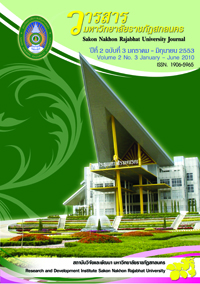การพัฒนาหุ่นยนต์ช่วยสอนประกอบการจัดกิจกรรมการเรียนรู้คณิตศาสตร์ของ นักเรียนชั้นประถมศึกษาปีที่ 6 ที่มีผลสัมฤทธิ์ทางการเรียนคณิตศาสตร์ต่ำ
Abstract
บทคัดย่อ
การวิจัยครั้งนี้เป็นการพัฒนาหุ่นยนต์ช่วยสอนจาก “หุ่นมหัศจรรย์” เดิมเป็น “หุ่นมหัศจรรย์ 2” และ “หุ่นมหัศจรรย์ 3” โดยมีวัตถุประสงค์เพื่อ 1) พัฒนาการจัดกิจกรรมการเรียนรู้ กลุ่มสาระการเรียนรู้คณิตศาสตร์ เรื่อง จำนวนนับ และการบวก การลบ การคูณ การหารจำนวนนับ โดยใช้หุ่นยนต์ช่วยสอนที่มีประสิทธิภาพตาม เกณฑ์ 75/75 และหาดัชนีประสิทธิผลการจัดกิจกรรม 2) เปรียบเทียบผลสัมฤทธิ์ทางการเรียนระหว่างนักเรียน ที่เรียนโดยใช้หุ่นยนต์ช่วยสอน กับนักเรียนที่เรียนโดยวิธีปกติ 3) เปรียบเทียบเจตคติต่อวิชาคณิตศาสตร์ ระหว่างนักเรียนที่เรียนโดยใช้หุ่นยนต์ช่วยสอน กับนักเรียนที่เรียนโดยวิธีปกติ 4) ศึกษาความพึงพอใจของ นักเรียนที่เรียนโดยใช้หุ่นยนต์ช่วยสอน แบ่งวิธีดำเนินการออกเป็น 3ชุดโครงการย่อย ระหว่างปีการศึกษา 2547 - 2550 กลุ่มตัวอย่างที่ใช้ในการวิจัยเป็นนักเรียนชั้นประถมศึกษาปีที่ 6 โรงเรียนท่าแร่วิทยา สำนักงานเขต พื้นที่การศึกษา สกลนคร เขต 1 ซึ่งได้มาจากการสุ่มอย่างง่าย (Simple Random Sampling) เครื่องมือที่ใช้ในการ วิจัย มี 4 ชนิด คือแผนการจัดการเรียนรู้โดยใช้หุ่นยนต์ช่วยสอนและแผนการจัดการเรียนรู้โดยวิธีปกติ รูปแบบ ละ 11 แผน แบบทดสอบวัดผลสัมฤทธิ์ทางการเรียนคณิตศาสตร์ จำนวน 40 ข้อ มีค่าอำนาจจำแนก 0.25 - 1.00 ค่าความเชื่อมั่นเท่ากับ 0.92 แบบวัดเจตคติต่อวิชาคณิตศาสตร์ จำนวน 25 ข้อ มีค่าอำนาจจำแนก 2.16 - 4.58 ค่า ความเชื่อมั่นเท่ากับ 0.92 และแบบวัดความพึงพอใจของนักเรียนต่อหุ่นยนต์ช่วยสอนจำนวน 20 ข้อ มีค่าอำนาจ จำแนก 2.72 - 4.79 ค่าความเชื่อมั่นเท่ากับ 0.91 สถิติที่ใช้ในการวิเคราะห์ข้อมูล ได้แก่ ร้อยละ ค่าเฉลี่ย ส่วน เบี่ยงเบนมาตรฐาน และการทดสอบที
ผลการวิจัยปรากฏดังนี้
1) การจัดกิจกรรมการเรียนรู้โดยใช้หุ่นยนต์ช่วยสอน มีประสิทธิภาพ 77.02/76.67 และดัชนี ประสิทธิผล 0.55 ซึ่งสูงกว่าเกณฑ์ที่ตั้งไว้
2) นักเรียนที่เรียนโดยใช้หุ่นยนต์ช่วยสอน มีผลสัมฤทธิ์ทางการเรียน สูงกว่านักเรียนที่เรียนโดยวิธี ปกติ อย่างมีนัยสำคัญทางสถิติที่ระดับ .01
3) นักเรียนที่เรียนโดยใช้หุ่นยนต์ช่วยสอน มีเจตคติต่อวิชาคณิตศาสตร์ สูงกว่านักเรียนที่เรียนโดยวิธี ปกติ อย่างมีนัยสำคัญทางสถิติที่ระดับ .01
4) นักเรียนมีความพึงพอใจต่อหุ่นยนต์ช่วยสอนในระดับ มากที่สุด
โดยสรุป การใช้หุ่นยนต์ช่วยสอนประกอบการจัดกิจกรรมการเรียนรู้ มีประสิทธิภาพ และ ประสิทธิผลเอื้อต่อการพัฒนาผลสัมฤทธิ์ทางการเรียน และทำให้นักเรียนมีเจตคติที่ดีต่อวิชาคณิตศาสตร์ จึงควร สนับสนุนให้ครูนำไปใช้ในการจัดกิจกรรมการเรียนการสอนในกลุ่มสาระการเรียนรู้คณิตศาสตร์ต่อไป
Abstract
This study was to develop the instructional assisting robot from the original “Amazing Robot” to “Amazing Robot 2” and finally to “Amazing Robot 3”.Thus the purposes of this study were : 1) to develop learning activities in the mathematics learning entitled counting number and the addition, the subtraction, the multiplication and the division of counting number by using the instructional assisting robot with a required efficiency of 75/75; and to find out the effectiveness indices of learning activities by using the instructional assisting robot; 2) to compare the achievement learning abilities of the students who learned using between the instructional assisting robot and the ordinary method; 3) to compare the attitudes towards mathematics learning the student who learned using the instructional assisting robot and the ordinary method;4) to study students satisfaction with the instructional assisting robot. The project was divided into three sub - projects which were run during academic years 2004 - 2008. The samples used in this study consisted of 2 classrooms of Prathomsuksa 6 students attending Tharaewittaya School under the Office of Sakon Nakhon Educational Service Area 1, selected by using simple random sampling. Four types of the instruments used in the study were learning plans using instructional assisting robot and the ordinary method, 11 plans each; a 40 - item mathematics achievement test with discriminatinon power ranging from 0.25 - 1.00 and a reliability of 0.91; a 25 - item scale on student’s attitude toward mathematics learning with discrimination power ranging from 2.16 - 4.58 and a reliability of 0.91 ; a 20 item - scale on satisfaction with learning activities using the instructional assisting robot with discrimination power ranging from 2.72 - 4.79 and a reliability of 0.91. The statistics used for analyzing data were percentage, mean, and standard deviation and t-test (independent samples) was employed for testing hypotheses.
The results of study were as follows :
1. The learning activities using the instructional assisting robot had efficiency of 77.02/76.67 and had effectiveness indices of 0.55 which were higher than the set criteria.
2. The students who learned using the instructional assisting robot showed higher learning achievement than those who learned using the ordinary method at .01 level of significance.
3. The students who learned using the instructional assisting robot showed better attitudes towards mathematics learning than those who learned using the ordinary method at .01 level of significance.
4. The students who learned using the instructional assisting robot indicated satisfaction with the instructional assisting robot as a whole at the highest level.
In conclusion, the mathematics learning activities using the instructional assisting robot were efficient and effective. Also, the instructional assisting robot should be supported to implement the instructional in learning - teaching mathematics strand in the future









